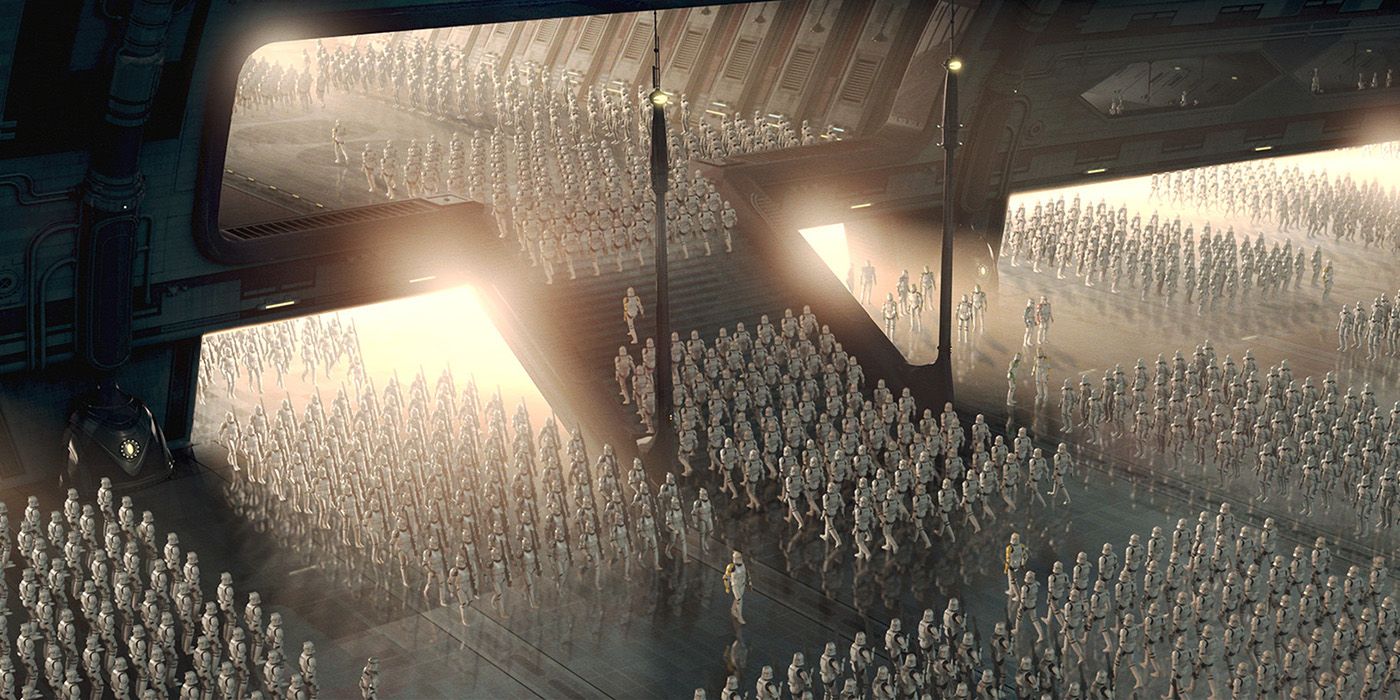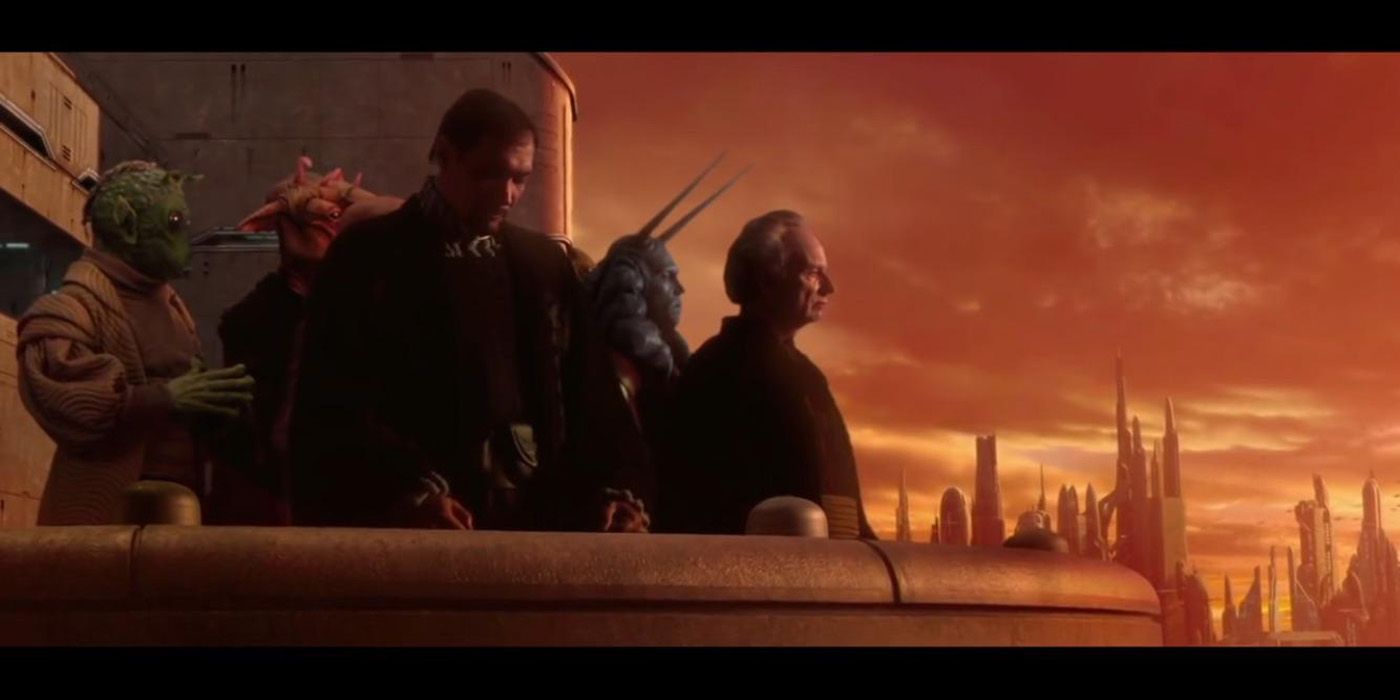For those who are paying close attention to the Star Wars universe, Sheev Palpatine is a cunning and devious agent. He is at his best when his hand is least seen in the movements of the Sith Grand Plan. For the audience, much of what Palpatine is up to is background information - even presumed to the point of non-existence.
The foreground action of Star Wars: Attack of the Clones follows Obi-Wan in his pursuit of an assassin and Anakin in his pursuit of controlling his personal life. The implications of their actions and the results, however, tell a vastly different story. A story about the effortless success of Supreme Chancellor Palpatine once again manipulating everyone around him like pawns. Attack of the Clones presents the audience with a full tour of the depth of Darth Sidious’ plot against the Galaxy and the Jedi Order. By its conclusion, it is a story of his greatest victory.
The middle chapter of the Star Wars Prequel Trilogy bears the weight of being the lowest-grossing movie of the Prequels. Despite having a higher review rating than Phantom Menace, Attack of the Clones earned a heap less than its predecessor. There is even a debate as to whether it was worse than Phantom. Viewers considered it a simple by-the-numbers plot with shallow characters. It has exciting battle scenes and lightsaber duels, but not enough to elevate the lazy river of a story meandering between.
The joy of Attack of the Clones comes from examining the puppeteering being done by Palpatine. Deep beneath Obi-Wan’s investigation, even further below Anakin and Padmé’s romance, is a layer of conspiracy connecting the tissue of Phantom Menace all the way to A New Hope. If viewed in this way, Attack of the Clones is the flawless execution of Darth Sidious’ master plan.
Attack of the Clones begins with the assassination attempt of Senator Amidala. This event, regardless that it failed, initiates the intricate web spun by Palpatine.
Marching to The Fall of Democracy
Thread one directs Obi-Wan Kenobi to investigate the assassination attempt of Amidala. Obi-Wan’s journey showcases the cradles of Palpatine’s conspiracy. It can be said that had Nute Gunray never tried to kill Amidala Obi-Wan would never have discovered everything that he did in his detective work. Yet, Gunray received permission and the support of Count Dooku, which means Palpatine was fully aware of the plan. This then means that her fate was intentionally jeopardized by Palpatine to lure Obi-Wan and Anakin into a trap, as will be explored in a moment in threads two and three.
Obi-Wan pursues the trail set out by Jango Fett’s poisoned dart to the cloner labs of Kamino. He is dumbfounded to learn that Jedi Master Sifo Dyas kicked off the clone army ten years earlier. Obi-Wan then confronts Jango Fett and chases him to Geonosis, only to get captured after eavesdropping on the Separatist’s plot.
The entire time from when Obi-Wan went to Kamino until he ended up in the Geonosian arena, he could do nothing but bear witness. It is as if Palpatine was rubbing his power in Obi-Wan’s face. Obi-Wan was a tourist to both of Palpatine’s armies, witnessing the homeworlds of the clone troopers and the factories of the droid army. With these two great forces, Palpatine would smash the Galaxy asunder, specifically, snuff out the Jedi.
Dooku’s Deceit – It’s a Trap!
Obi-Wan’s winding road led him right to Count Dooku. Dooku candidly revealed the truth of Sidious, that he controls the Galactic Senate, and then offered Obi-Wan an apprenticeship under his Sith mastery. Just as Palpatine was secretly gloating to Obi-Wan to witness the loins of the Republic’s end, so to was Palpatine testing Dooku. It is intentional Sith teaching that the apprentice will betray and kill the master to assume the mantle for themselves.
Palpatine controlled the game so well that he manipulated Obi-Wan into Dooku’s arms so that Dooku could spend his Sith betrayal card. Palpatine created the situation to which Dooku would make his play. That it failed was exactly what Palpatine always planned. Had Dooku been a smarter Sith, he would have known the depth of forethought his master had and sniffed out the trap. The result was a swift beheading at the hands of his replacement in the beginning of Revenge of the Sith. Dooku was used and then expended.
Second, Obi-Wan was not only lured as a pawn between Dooku and Palpatine, but the fact that Palpatine allows his entire plan to be exposed by Dooku shows a high level of control and confidence. Obi-Wan was snared in Palpatine’s plot from Kamino to Geonosis. Even learning the deepest darkest secret of the Sith could not change the fate of the Galaxy or the Jedi Order. Palpatine outmaneuvered the Jedi so well that he could do it in plain sight and not be confronted for it until it was way too late.
In Attack of the Clones Palpatine engineers the cause of the Clone Wars, generates both armies, and places the Jedi into a conflict that they can neither control nor predict. Obi-Wan learned about it from Dooku, expressed it to the Jedi Council, only to have them fall right into command of Palpatine’s rank and file army. This ultimately delivers them to their doom, as they are separated from each other and surrounded by an overwhelming enemy.
Owner of a Lonely Heart
Layered on top of all of this is the heart of the web, Palpatine’s greatest play. Threads one and two involve Obi-Wan, the fall of the Republic and the Jedi Order and a test of Count Dooku. Thread three is the prime rib, the au jus. Palpatine cleverly separated Anakin from the rest of the Jedi, especially his Master, and positioned him right into the bosom of Padmé Amidala.
The failed assassination attempt brought these two together in an intimate way, a way that would never have been allowed or possible had Nute Gunray been denied trying to kill her. Their absconding to Naboo gave Anakin an opportunity to make decisions for himself, which led to his own confusion and misery. When Shmi Skywalker was put in danger (no doubt orchestrated by Palpatine from afar), Anakin rushes in with rage, massacring the Tusken Raiders. He had a lot of options available to him. He could have asked for help from the Jedi Order. Instead, he chose the path of anger and darkness.
In losing his mother, he is drawn closer to his feelings for Padmé, he grows more attached to her, making the threat to her life in Revenge of the Sith even more dire and pronounced. Just as Palpatine brought Obi-Wan to Dooku, he maneuvered Padmé to Anakin. Padmé was Palpatine’s greatest power play because not only had he manipulated her ten years earlier into gaining the title of Supreme Chancellor, but he dangled her in front of Anakin to tempt his youthful loins! Later, in Revenge of the Sith, Palpatine will cash in on this affair to great effect.
On the outside, Star Wars: Attack of the Clones is a simple mystery with science fantasy trappings. Viewing it with a consideration of Palpatine’s plot against the Jedi, it is a clear picture of his mastery over the entire Galaxy. Everyone, including the Jedi Order, are subject to his artful, surgical, plays. By the end of Attack of the Clones, Palpatine has already won the Galaxy. Everything else, waging the Clone Wars, executing Order 66, the final trigger of Anakin’s fall to the dark side, is pure gravy.




